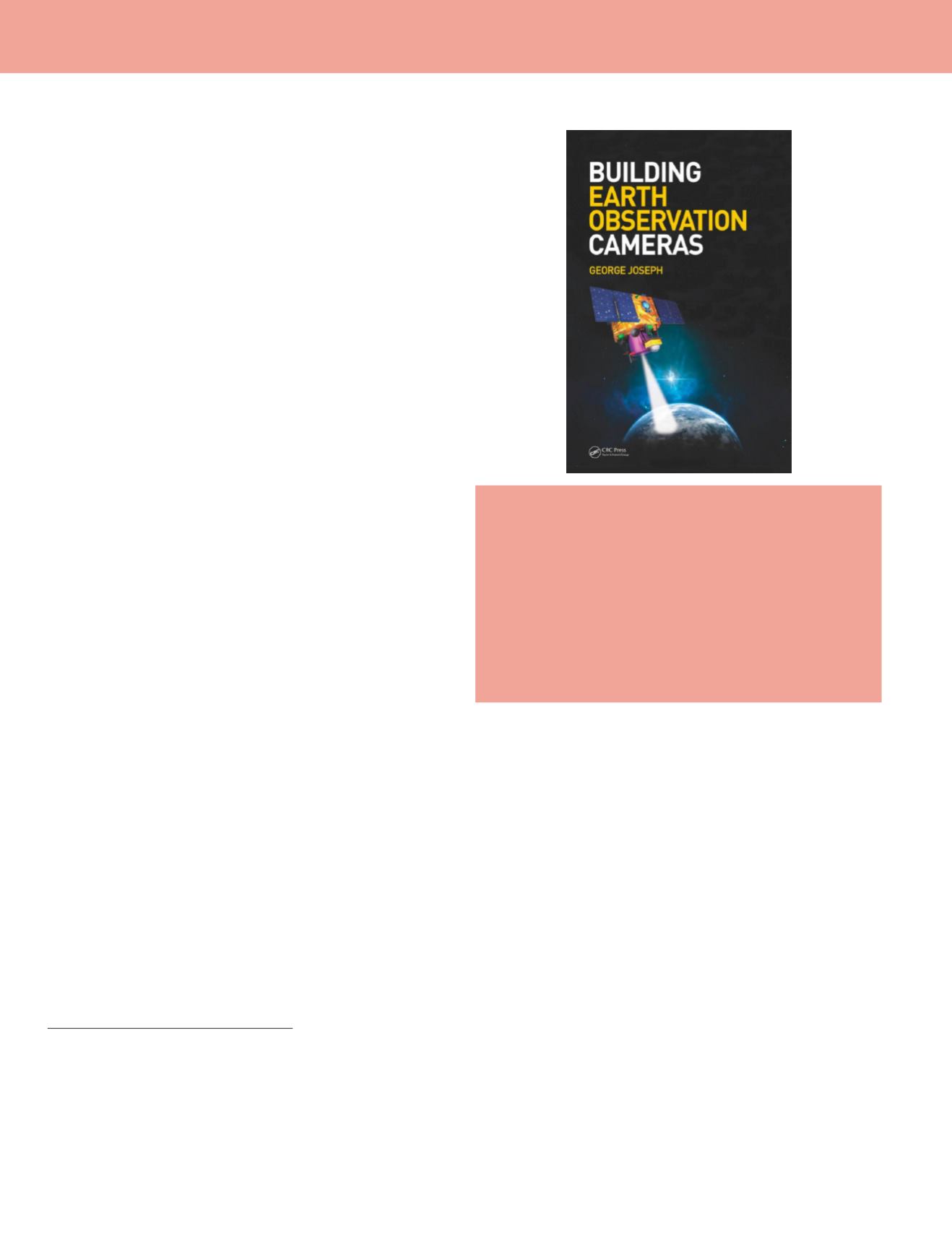
588
August 2016
PHOTOGRAMMETRIC ENGINEERING & REMOTE SENSING
BOOK
REVIEW
Building Earth Observation Cameras
George Joseph
CRC Press, Taylor & Francis Group, 2015. 368 pages. Hardcover.
ISBN-10: 1466566477. $116.
Reviewed by
Jim Bethel, Faculty, School of Civil
Engineering, Purdue University, West Lafayette,
Indiana. Megan Miller, P.h.D. Student, Purdue
University, West Lafayette, Indiana.
This is an excellent book, whose publication is very timely.
Increasing numbers of countries and organizations are
venturing into the world of owning and operating remote
sensing systems. In the past satellite imagery was provided
to us by the high priests at NASA, JPL, NRO, and other
national organizations. Entry level vehicles such as cubesats
may now allow armchair scientists, photogrammetrists, and
others to contemplate participating in the creation of their
own earth observation cameras. Conventional remote sensing
texts cover topics such as radiometry, surface interactions,
classification, image processing, and registration/rectification,
without venturing into the practical details of how sensors are
designed and built. Up to now, the requisite knowledge has
generally resided in the heads of a few specialists. This book
pulls back the curtain and illuminates many of the dark arts
required to successfully build and operate a camera in space.
Dr. Joseph has had a long and distinguished career in the
Indian Space Research Organization, and has had leadership
roles in the development of many of their successful missions,
including INSAT and the IRS series.
There is a thorough chapter on optics which includes a
taxonomy of telescope types, describing the pros and cons
of each. This chapter includes a review of mirror substrate
materials, where we are introduced to the remarkable
beryllium, a metal which is 31% lighter than aluminum and
five times stiffer, along with silicon carbide and Zerodur. Both
material and thermal properties are reviewed along with
practical advice on machining and on adhesives to hold things
together. In the overview chapter, there is guidance offered on
different ways to compute the Modulation Transfer Function
(MTF), including point targets, line targets, edge targets, knife
edges, and higher resolution images. Each chapter helpfully
includes a long list of cited references for further study.
The author highlights the evolution of Landsat from a
whiskbroom to a pushbroom architecture in the transition
from L7 to L8. The trend toward pushbroom architecture
has compelled all focal plane designers to deal with the
challenge of creating lengthy virtual detector arrays from
shorter, commercially available arrays by various means such
as staggering and optical butting with beamsplitters. The
author guides us through his own design options for LISS-
1, culminating in the choice of multiple optical apertures
rather than a single one. He further demystifies the need
for image space telecentric lenses when using interference
filters. When deciding whether to do lossy compression on
data for transmission to the ground station, we learn that this
has minimal effects on DEM generation, but can introduce
significant degradation in ML classification.
We learn of several initiatives to achieve high resolution
imaging from GEO orbit. This would have obvious benefits
in terms of a revisit time of minutes or seconds rather than
days or weeks as we have with LEO. Several different
architectures for hyperspectral cameras are presented, along
with corresponding examples of existing missions employing
those architectures. In chapter ten, there are presented some
unique challenges of the space environment which will be
unfamiliar to many readers. These include: outgassing, the
vacuum induced expulsion of volatile gases from various
components which can contaminate optics and weaken parts;
cold welding, the unanticipated fusing of clean metal parts in
tight contact; and heat management, since convection will not
be available to transfer heat energy.
There are numerous such pearls of wisdom buried in the
book, no doubt many learned by hard experience. As to
suggestions or criticisms of the book, a few come to mind. A list
of variables and acronyms, with page numbers for reference
would be helpful. A chapter on orbit considerations and some
Photogrammetric Engineering & Remote Sensing
Vol. 82, No. 8, August 2016, pp. 588–591.
0099-1112/16/588–591
© 2016 American Society for Photogrammetry
and Remote Sensing
doi: 10.14358/PERS.82.8.588


